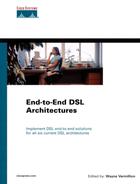Summary
In general, most potential DSL subscribers must be within 5486 meters (18,000 feet) of the central office equipment, whether in a traditional CO or in a remote terminal. This distance represents the traditional Carrier Serving Area (CSA) defined by remote terminals that extend voice service from the central office, and it has been accepted over decades for voice service. The relatively recent use of DSL repeaters is extending this reach. DSL equipment can be installed in a remote terminal, but the equipment must be made compact and environmentally hardened. Even before the equipment is accepted, regulatory issues must be addressed to define colocation and line sharing between the incumbent provider and the competitive DSL provider.
More than a century of copper telephony infrastructure must be evaluated before DSL technologies can be implemented over the existing POTS network. Legacy voice technology might present impairments that prevent DSL service entirely or at least inhibit optimal DSL service. In some cases, the cost to remove impairments might be so great that providers opt not to offer DSL in certain areas or might limit advertised bit rates. These impairments include the following:
Load coils (prevent DSL operation)
Bridged taps (can lower the DSL bit rate and must be calculated to offer DSL service guarantees)
Crosstalk and frequency interference (countered by careful separation of cables with different modulations)
Copper impedance mismatches (must be documented and calculated for their effect throughout the copper plant)
Countering impairments starts with modern DSL's own automatic rate adaptation. Protection from unwanted noise is measured by the SNR margin. Although sophisticated error-correction algorithms are available (such as Reed-Solomon Encoding and Trellis Coding), these error-correction algorithms depend on the use of bit interleaving to spread out the error bits for maximum efficiency. Together, bit interleaving, with its redundant check bytes, and error-correction algorithm(s) create en route delay and processor loads that are unnecessary for certain types of traffic, such as standard IP data traffic, which can be retransmitted from end to end without taxing the processors and adding delay. This traffic rides in the fast path. Other types of traffic, such as streaming video, cannot be efficiently retransmitted in the case of received errors and must be corrected as much as possible en route. This traffic rides in the second of two paths, the interleaved path.
